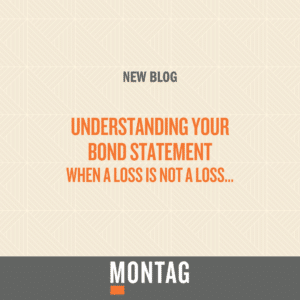 By: MONTAG Wealth
By: MONTAG Wealth
Portfolio managers use bonds to earn income for clients while offering a level of stability in asset value. Stocks, otherwise known as equities, are invested in businesses to grow with the economy, and as a result, the path of their returns can be volatile. The blending of bonds and equities can allow for the growth of assets, the stability of value, provides for any cash needs over the next few years, and can even produce income, if needed.
So why does it look like I am losing money in the bond portion of my portfolio when I am looking at my account statement? The bond market, like the stock market, trades minute by minute throughout the day with prices adjusting to changes in the interest rate environment. As interest rates go up, bond prices go down and as interest rates go down, bond prices go up.
When looking at your account statement, it will show the daily change in bond prices just like the equity portion of the statement, but unless you sell the bond, these adjustments won’t change the final return you earn on a bond. Unlike stocks, when we buy a bond and hold it to maturity, an investor knows what they are going to earn. If a bond yields 5% at purchase, whether you paid a premium or discount, it will ultimately mature at its face, or “par value”. So as the price fluctuates before maturity, an investor knows that they will actually receive 5% in income each year along with getting back the stated par value at maturity.
Ideally, the bond portion of a portfolio should be tailored to each client’s investment objectives. At MONTAG, we purchase most bonds in the secondary market, meaning, instead of buying at the auction when the bonds are issued, we can choose for each client the dollar amount, quality, maturity, and price. Buying in the secondary market provides MONTAG with the flexibility to construct a portfolio that will meet a client’s need for income and allows us to time bond maturities to coincide with cash needs. This tailored approach allows us to set the goal of achieving the highest yield to maturity while ensuring cash is available when needed.
Building a portfolio this way allows us to hold most bonds to maturity. Though you may see prices fluctuate on a statement, by holding to maturity you are most likely to not only get the original investment returned to you, but also to lock in the income that was fixed on the day the bond was purchased.
The information provided is for illustration purposes only. It is not, and should not be regarded as “investment advice” or as a “recommendation” regarding a course of action to be taken. These analyses have been produced using data provided by third parties and/or public sources. While the information is believed to be reliable, its accuracy cannot be guaranteed. MONTAG employees do not provide legal or tax advice. For specific legal or tax matters, you should consult with your own legal and/or tax advisors. There are risks associated with investing in securities. Investing in stocks, bonds, exchange-traded funds, mutual funds, and money market funds involves risk of loss. Loss of principal is possible.
